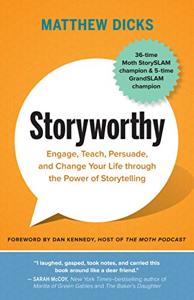
Want to learn the ideas in Storyworthy better than ever? Read the world’s #1 book summary of Storyworthy by Matthew Dicks here.
Read a brief 1-Page Summary or watch video summaries curated by our expert team. Note: this book guide is not affiliated with or endorsed by the publisher or author, and we always encourage you to purchase and read the full book.
Video Summaries of Storyworthy
We’ve scoured the Internet for the very best videos on Storyworthy, from high-quality videos summaries to interviews or commentary by Matthew Dicks.
1-Page Summary of Storyworthy
Overview
Stories are a critical part of human communication. Whether it’s around the campfire or in the boardroom, stories can stick with people forever. However, there is a way to tell better and more memorable stories about our experiences that will have an impact on those who hear them.
In this book, we will learn how to tell a good story. We’ll discover the ingredients that make up a successful story and look at what do’s and don’ts should be included in the telling of it. We’ll also take a look at how to begin and end your story as well as what you should include or leave out if you want maximum impact from your audience.
The author explains why every good story needs to have a five-second moment, what that is and how it works. He also talks about the importance of having a test for your story, so you can see if it’s working or not. The author then tells us how we should start our stories in order to make them more interesting.
Big Idea #1: Great stories contain an element of change and cast the storyteller as the protagonist.
The author teaches people how to tell stories about themselves and their experiences. He believes that storytelling helps everyone be a better communicator.
One of the most important things to remember when telling a story is that it should reflect some type of change. This doesn’t necessarily mean improvement, but there must be some sort of change in your character or plot. Otherwise, you’re just going to bore your listeners. Think about the worst movies you’ve ever seen – even they have certain types of changes in them as well as terrible acting and bad dialogue.
The most interesting stories are ones where the characters go through some sort of change. They might be funny, sad or scary, but they’re always about people who grow and develop as a result of their experiences. Stories that don’t have any kind of character development aren’t very interesting to listen to because they don’t leave an impact on you after you’ve heard them.
It’s also important to tell stories that highlight your value as a person. People want to hear about you rather than someone else because they’re interested in what makes you unique and interesting.
It is very important to tell your own story rather than someone else’s. It takes a lot of courage to do that, and people will appreciate it more because they can relate better.
In addition to that, it’s not wrong to tell someone else’s story. You just need to do so from your perspective. For example, the author taught Holocaust survivors’ children how to tell their parents’ stories through a program called Voices of Hope. They learned how structure those stories in a way that is relatable and engaging for others who don’t know much about the Holocaust.
Big Idea #2: Tell your story without any pre-prepared theatrical or poetic flourishes.
Stories must pass what the author calls “the dinner test.” To see if a story is good, ask yourself: “Would I tell this story to someone over dinner?” If you wouldn’t, then it’s probably not a very good story.
When you’re telling a story, remember to be yourself and don’t change your tone or mannerisms. This is how you should tell the story in front of an audience as well.
Just think about the way some storytellers act in front of an audience. They make strange gestures with their hands while telling a story, like fluttering their hands to show how an idea came to them. Would you do this at the dinner table? Probably not. Remember that you’re not putting on a one-person play; just tell your story normally.
In addition to over-the-top hand gestures, people tend to use a lot of unnecessary words when they speak. This is especially true when they’re on stage or writing. You don’t want to bore your audience with flowery language and long, drawn out descriptions. Remember that you’re telling stories here, not writing poetry—so keep it simple!





